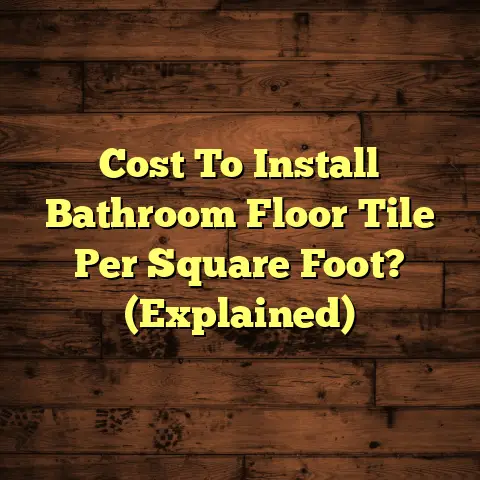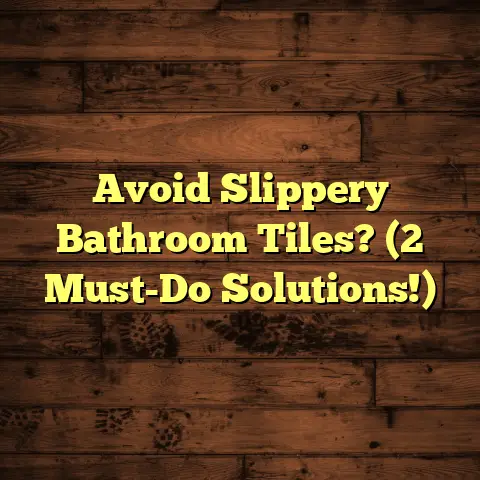Concrete Moisture Issues? (2 Min. Test!)
Chances are, you might be dealing with a concrete moisture issue.
Before you panic, let’s try a quick fix. Grab a roll of plastic sheeting (even a heavy-duty trash bag will do) and some tape. Tape a piece down on your concrete floor and leave it for a bit.
This creates a temporary moisture barrier. You can also apply a concrete sealant if the area is small and localized. These are temporary solutions that buys you some time.
But hold on! This is just a band-aid. The real key is understanding why the moisture is there in the first place.
Think of it like this: you can keep mopping up a leak, but until you fix the pipe, the water keeps coming.
Concrete moisture problems can wreak havoc on your flooring. It can lead to mold growth, structural damage, and a whole host of headaches.
In this article, I’m going to walk you through everything you need to know about concrete moisture. We’ll cover the causes, symptoms, solutions, and even a super simple 2-minute test you can do yourself.
Let’s dive in!
Section 1: Understanding Concrete Moisture Issues
Okay, so what exactly are concrete moisture issues?
Simply put, it’s when concrete has more moisture than it should. Now, concrete is naturally porous, which means it can absorb and release moisture. The problem arises when the moisture levels become excessive.
This can happen for a number of reasons, which we’ll get into later. But first, let’s talk about why it’s such a big deal.
Excess moisture can compromise the integrity of the concrete itself. It can also damage any flooring materials installed on top of it.
Think about wood flooring, for example. Wood expands and contracts with moisture. If it’s constantly exposed to dampness from the concrete below, it can warp, buckle, or even rot.
The same goes for tile. Moisture can weaken the adhesive bond between the tile and the concrete, leading to loose or cracked tiles.
The Science Behind It:
Concrete’s permeability is a crucial factor. Permeability refers to how easily liquids and gases can pass through a material. Concrete’s permeability depends on factors like the water-to-cement ratio used during mixing.
A higher water-to-cement ratio generally results in more porous concrete. Absorption rate is another key concept. This refers to how quickly concrete absorbs moisture.
These two factors determine how susceptible your concrete is to moisture problems.
Surface vs. Trapped Moisture:
It’s important to distinguish between surface moisture and moisture trapped within the slab. Surface moisture is usually temporary, like condensation on a cool surface.
Trapped moisture, on the other hand, is moisture that’s been absorbed into the concrete and is lingering there. This is the kind of moisture that causes long-term problems.
Section 2: Common Causes of Concrete Moisture Problems
Alright, let’s get to the root of the issue. What causes concrete to become excessively moist?
Here are some of the most common culprits:
-
Poor Drainage and Water Accumulation:
This is a big one. If water is allowed to pool around the foundation of your building, it can seep into the concrete. Think about rainwater runoff, leaky gutters, or improper grading around the foundation.
I’ve seen countless cases where simply improving the drainage around a building has solved the majority of the moisture problems. For example, a client of mine had water pooling against their foundation during heavy rains. We installed a French drain system to redirect the water away from the building. Problem solved!
-
Ground Moisture and Rising Damp:
Ground moisture is moisture that naturally exists in the soil. This moisture can rise through the concrete slab through a process called capillary action.
This is especially common in basements and slabs that are in direct contact with the ground. I once worked on a project in an older home with no vapor barrier under the slab. The concrete was constantly damp due to rising damp from the soil.
-
Inadequate Curing and Drying:
This is a common issue with new concrete pours. Concrete needs to be properly cured, which means keeping it moist for a certain period of time after it’s poured.
This allows the concrete to hydrate properly and reach its full strength. If concrete dries too quickly, it can become more porous and susceptible to moisture absorption.
I remember a situation where a contractor rushed the curing process on a large commercial slab. The concrete ended up cracking and absorbing moisture like a sponge. It was a costly mistake that could have been avoided with proper curing.
-
External Factors:
Weather conditions and humidity levels can also play a role. In humid climates, concrete can absorb moisture from the air.
Temperature fluctuations can also cause condensation on the surface of the concrete. I live in a region with hot, humid summers. I’ve seen concrete floors in unconditioned spaces become damp simply from the humidity in the air.
Case Studies:
Let’s look at a couple of real-life examples:
-
Case Study 1: The Leaky Basement:
A homeowner contacted me about a persistent musty smell in their basement. Upon inspection, I found efflorescence on the concrete walls and signs of mold growth.
The culprit? Poor drainage around the foundation and a lack of a proper vapor barrier. We installed a French drain system, applied a waterproof coating to the walls, and installed a dehumidifier.
The musty smell disappeared, and the basement became a usable space again.
-
Case Study 2: The Buckled Hardwood Floors:
A business owner complained that their newly installed hardwood floors were buckling. After testing the concrete slab, we found that it had an extremely high moisture content.
The cause? The concrete had not been properly cured, and there was no vapor barrier installed. We had to remove the hardwood floors, allow the concrete to dry completely, install a vapor barrier, and then reinstall the flooring.
It was an expensive and time-consuming process, but it was necessary to prevent further damage.
Section 3: Symptoms of Concrete Moisture Issues
Okay, so how do you know if you have a concrete moisture problem? Here are some telltale signs to watch out for:
-
Efflorescence:
This is a white, powdery substance that appears on the surface of the concrete. It’s caused by mineral salts being dissolved by moisture and then deposited on the surface as the moisture evaporates.
Efflorescence is a clear sign that moisture is migrating through the concrete.
-
Mold and Mildew Growth:
Mold and mildew thrive in damp environments. If you see mold or mildew growing on your concrete floors or walls, it’s a strong indication that there’s a moisture problem.
Mold can also cause health problems, so it’s important to address it promptly.
-
Cracking and Spalling:
Excessive moisture can weaken concrete, leading to cracks and spalling (where the surface of the concrete flakes off). This is a sign of serious structural damage.
-
Buckling or Warping of Flooring Materials:
As we discussed earlier, moisture can cause wood flooring to buckle or warp. It can also cause tile to crack or become loose.
If you notice any of these issues with your flooring, it’s important to investigate further.
-
Musty Odors:
A musty odor is a classic sign of moisture problems. It’s caused by mold and mildew growth.
If you smell a musty odor in your basement or on your concrete floors, it’s time to take action.
-
Reduced Air Quality:
Moisture problems can also affect your indoor air quality. Mold spores can become airborne, leading to respiratory problems and other health issues.
Early Detection:
The key to preventing serious damage is to identify these symptoms early. Regularly inspect your concrete floors and walls for any signs of moisture.
Pay particular attention to areas that are prone to moisture, such as basements, bathrooms, and kitchens.
Section 4: The 2-Minute Moisture Test
Alright, let’s get to that 2-minute moisture test I promised you. This is a super simple way to get a quick idea of whether or not you have a moisture problem.
Here’s how to do it:
-
Prepare the Area:
Start by cleaning the concrete surface. Remove any dirt, dust, or debris. You want to make sure you’re testing the concrete itself, not just the surface grime.
-
Cover a Section with Plastic:
Grab a piece of plastic sheeting (a trash bag works great). Cut a piece that’s about 1 foot by 1 foot.
-
Secure the Edges:
Tape the plastic sheet to the concrete floor, sealing all the edges. You want to create an airtight seal so that no air can get in or out.
-
Wait 2 Minutes:
Set a timer for 2 minutes and leave the plastic in place. This gives any moisture in the concrete a chance to condense under the plastic.
-
Check for Condensation:
After 2 minutes, carefully peel back the plastic and check for condensation or moisture accumulation underneath. Look closely for any signs of dampness on the concrete surface or on the underside of the plastic.
Interpreting the Results:
-
If you see condensation or moisture: This indicates that there is moisture present in the concrete. The more condensation you see, the more moisture there is.
-
If you don’t see any condensation: This doesn’t necessarily mean that there’s no moisture problem. It could simply mean that the moisture levels are low, or that the conditions aren’t right for condensation to form.
Important Note:
This 2-minute test is a quick and easy way to get a preliminary assessment of moisture levels. However, it’s not a substitute for professional moisture testing.
If you suspect you have a moisture problem, it’s always best to consult with a qualified professional.
Section 5: Long-Term Solutions for Concrete Moisture Issues
So, you’ve identified a concrete moisture problem. Now what? Here are some long-term solutions to consider:
-
Drainage Systems:
Improving drainage around your foundation is crucial. This can involve installing French drains, grading the landscape to slope away from the building, and cleaning out gutters and downspouts.
As I mentioned earlier, I’ve seen drainage systems make a huge difference in reducing moisture problems.
-
Vapor Barriers:
Vapor barriers are plastic sheets that are installed under the concrete slab to prevent moisture from rising up from the ground. They’re typically used in new construction.
If you’re building a new home or addition, make sure your contractor installs a proper vapor barrier.
-
Waterproofing Membranes and Sealants:
Waterproofing membranes and sealants can be applied to the surface of the concrete to create a barrier against moisture. These are available in a variety of formulations, including epoxy, polyurethane, and acrylic.
I’ve used waterproofing membranes on numerous projects, and they can be very effective in preventing moisture from penetrating the concrete.
-
Ventilation Systems:
Proper ventilation is essential for controlling moisture levels in basements and crawl spaces. This can involve installing vents, fans, or dehumidifiers.
Dehumidifiers are particularly effective at removing moisture from the air, which can help to prevent mold growth.
-
Regular Maintenance:
Regular maintenance is key to preventing moisture problems. This includes inspecting your foundation for cracks, cleaning gutters and downspouts, and addressing any leaks promptly.
A little bit of preventative maintenance can go a long way in preventing costly repairs down the road.
Pros and Cons:
Let’s take a look at the pros and cons of each solution:
| Solution | Pros | Cons |
|---|---|---|
| Drainage Systems | Effective at redirecting water away from the foundation | Can be expensive to install; may require excavation |
| Vapor Barriers | Prevents moisture from rising up from the ground | Only effective in new construction |
| Waterproofing Membranes | Creates a barrier against moisture; can be applied to existing concrete | May require surface preparation; can be expensive |
| Ventilation Systems | Helps to control moisture levels in basements and crawl spaces | May increase energy costs; requires regular maintenance |
| Regular Maintenance | Prevents moisture problems; relatively inexpensive | Requires consistent effort; may not be sufficient for severe moisture problems |
Section 6: Professional Assessment and Remediation
While some moisture problems can be addressed with DIY solutions, others require professional help. If you’re dealing with a severe moisture issue, it’s important to consult with a qualified professional.
Types of Professionals:
Here are some of the professionals who can help:
-
Contractors:
General contractors can assess moisture problems and recommend solutions. They can also perform repairs, such as installing drainage systems or applying waterproofing membranes.
-
Waterproofing Experts:
Waterproofing experts specialize in identifying and resolving moisture problems. They have the knowledge and experience to diagnose the root cause of the problem and recommend the most effective solutions.
-
Structural Engineers:
If you suspect that moisture is affecting the structural integrity of your building, it’s important to consult with a structural engineer. They can assess the damage and recommend repairs.
Professional Assessment:
A professional assessment typically involves:
-
Visual Inspection:
The professional will visually inspect your concrete floors and walls for signs of moisture, such as efflorescence, mold, and cracks.
-
Moisture Testing:
The professional will use moisture meters to measure the moisture content of the concrete. There are several types of moisture meters available, including pin meters and non-destructive meters.
-
Other Tests:
Depending on the situation, the professional may also perform other tests, such as a relative humidity test or a calcium chloride test.
Remediation Strategies:
Based on the assessment, the professional will recommend a remediation strategy. This may involve:
-
Repairing Cracks:
Cracks in the concrete can allow moisture to enter. The professional will repair any cracks with a suitable patching material.
-
Applying Waterproofing:
The professional may apply a waterproofing membrane or sealant to the surface of the concrete.
-
Improving Drainage:
The professional may recommend improving drainage around the foundation.
-
Installing Ventilation:
The professional may recommend installing a ventilation system to control moisture levels.
Section 7: Case Studies and Real-life Applications
Let’s take a look at some more case studies to illustrate how these solutions can be applied in real-life situations:
-
Case Study 3: The Damp Crawl Space:
A homeowner contacted me about a damp crawl space under their house. The crawl space was constantly humid, and there was a musty odor.
The culprit? Poor ventilation and a lack of a vapor barrier. We installed vents in the crawl space and laid down a plastic vapor barrier.
The crawl space became much drier, and the musty odor disappeared.
-
Case Study 4: The Condominium Complex Nightmare:
A condominium complex was experiencing widespread moisture problems. Many of the units had water damage, mold growth, and structural issues.
The cause? A combination of factors, including poor drainage, inadequate waterproofing, and improper ventilation. We developed a comprehensive remediation plan that involved repairing the drainage system, applying waterproofing to the exterior walls, and installing ventilation systems in the units.
It was a massive project, but it was necessary to protect the long-term integrity of the building.
-
Case Study 5: The Restaurant Debacle:
A restaurant owner had installed a new tile floor in their kitchen. Within a few months, the tiles started to crack and become loose.
The cause? The concrete slab had not been properly cured, and there was no vapor barrier installed. We had to remove the tile floor, allow the concrete to dry completely, install a vapor barrier, and then reinstall the tile.
The restaurant owner learned a valuable lesson about the importance of proper preparation.
Quick Fixes to Long-Term Solutions:
In some cases, a quick fix can be transformed into an effective long-term solution. For example, applying a concrete sealant to a small area of dampness can prevent further moisture penetration.
However, it’s important to remember that quick fixes are not always a substitute for addressing the underlying cause of the problem.
Failures and Lessons Learned:
I’ve also seen cases where moisture problems were not properly managed, leading to serious consequences. For example, I once worked on a project where a contractor tried to cover up a moisture problem by simply installing new flooring over the damp concrete.
The flooring failed within a few months, and the homeowner had to pay to have it replaced.
The lesson learned is that it’s always best to address the underlying cause of the moisture problem, rather than simply trying to cover it up.
Conclusion
Alright, we’ve covered a lot of ground in this article. Let’s recap the key points:
- Concrete moisture issues can cause serious damage to your flooring and your building.
- Common causes of moisture problems include poor drainage, rising damp, inadequate curing, and external factors.
- Symptoms of moisture problems include efflorescence, mold, cracking, buckling, and musty odors.
- You can use the 2-minute moisture test to get a quick idea of whether or not you have a moisture problem.
- Long-term solutions include drainage systems, vapor barriers, waterproofing membranes, ventilation systems, and regular maintenance.
- For severe moisture problems, it’s important to consult with a qualified professional.
Remember that quick fix we talked about at the beginning? Taping down a piece of plastic can give you a clue, but it’s not a long-term solution.
The key is to take proactive measures to assess and manage your concrete moisture problems. By doing so, you can avoid costly repairs and protect the long-term integrity of your building.
Don’t let moisture ruin your floors! Take action today!





